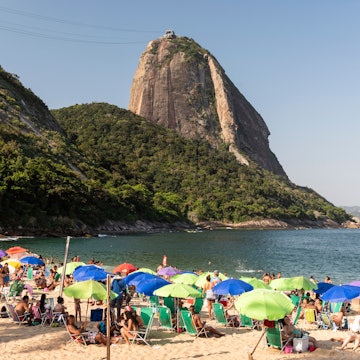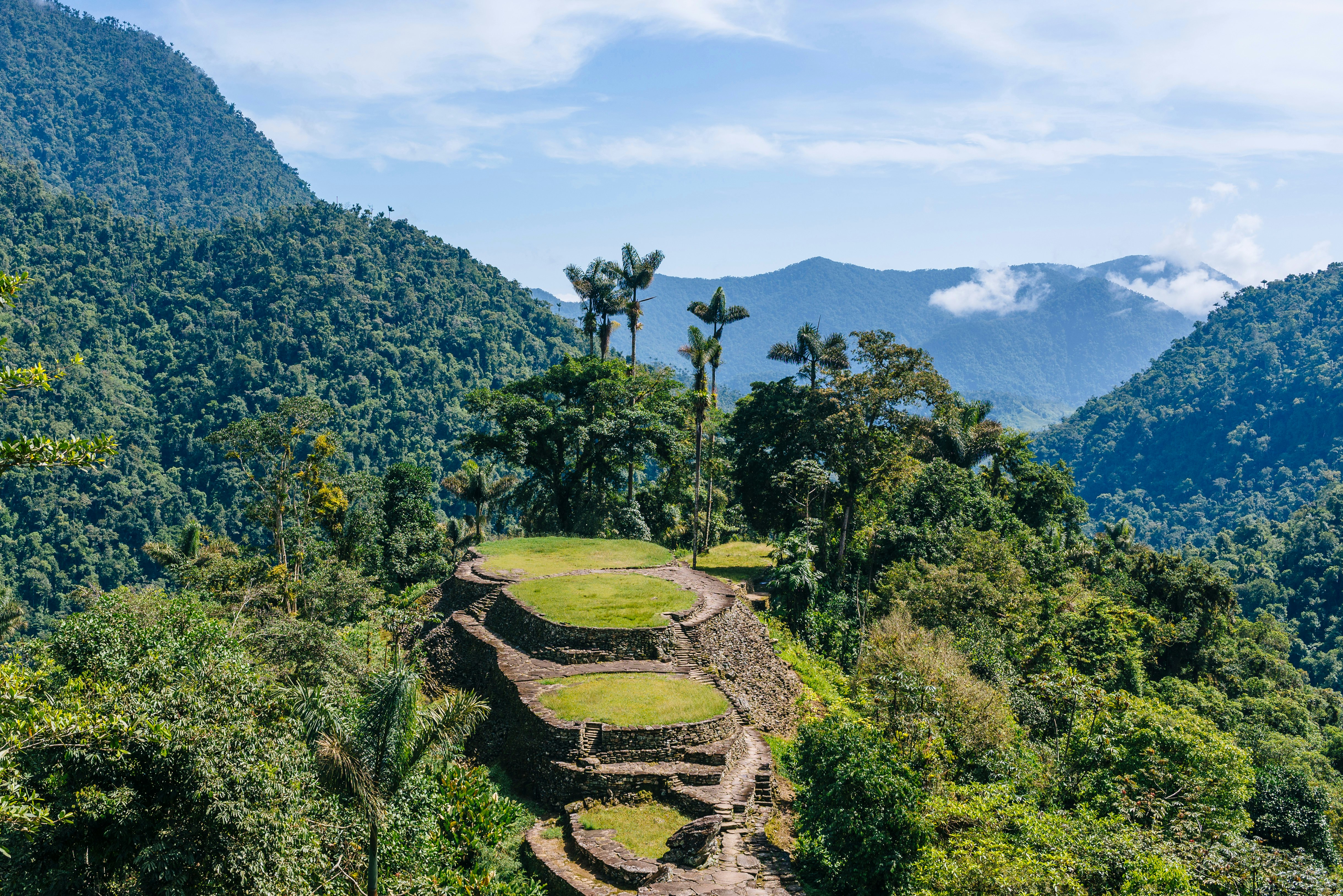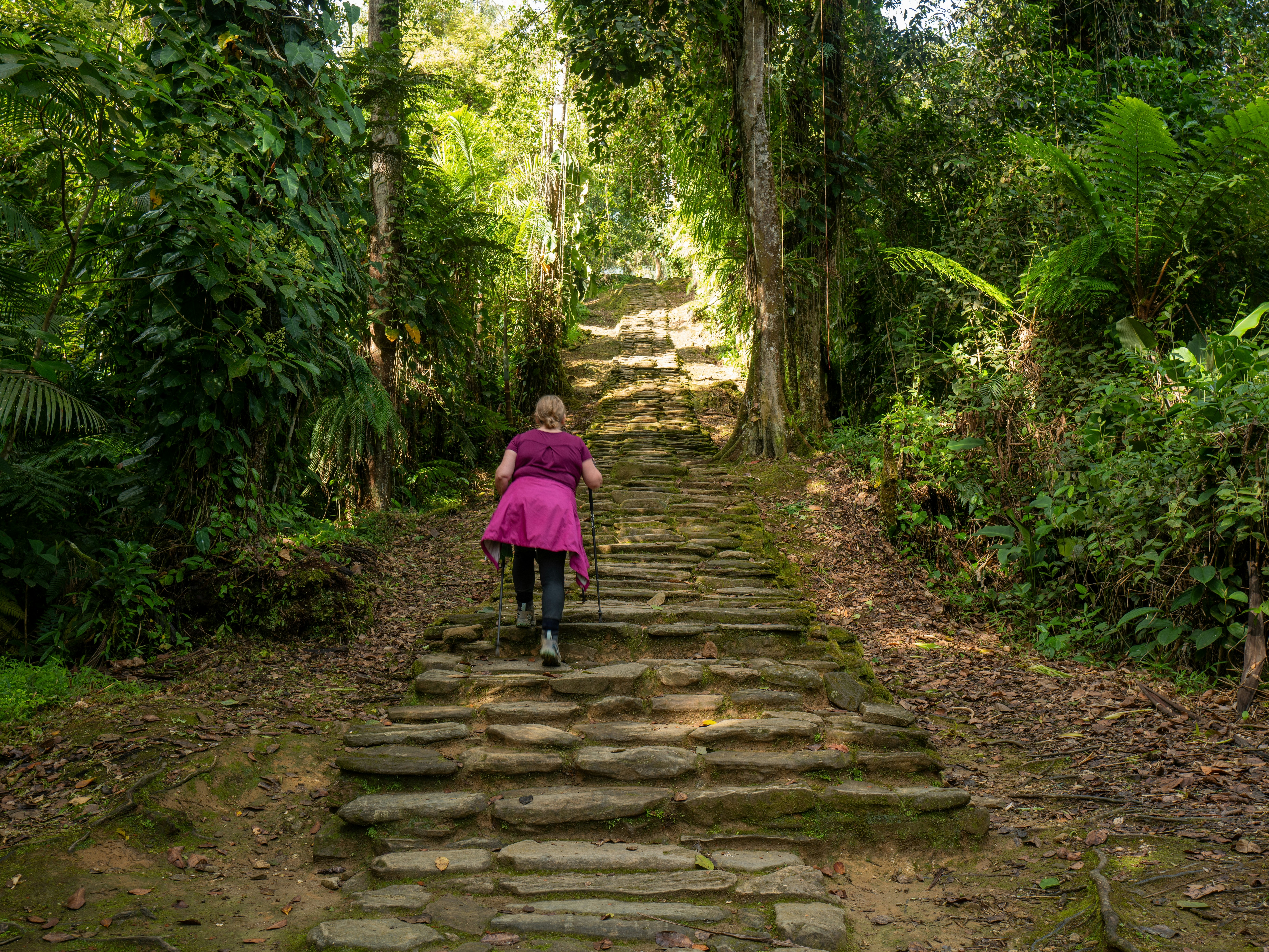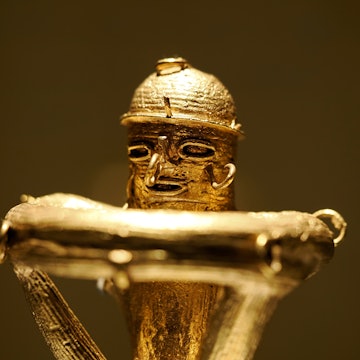

The terraces of the Lost City (Ciudad Perdida) are only accessible via a grueling multiday trek. Joerg Steber/Shutterstock
While it’s technically no longer “lost,” Colombia’s Lost City (Ciudad Perdida) still merits the intrigue its name suggests.
The Tayrona people built this stone city high up in the wild Sierra Nevada de Santa Marta mountain range sometime around 800 CE (600 years before Machu Picchu). Although very much known to the four Indigenous groups who descend from them and live in the region, the site (also known by its Indigenous name, Teyuna) gained its moniker when, after centuries of being swallowed by the jungle, guaqueros (grave robbers) revealed it (accidentally!) to the world in 1975.
Yet just because the Lost City is now “found,” it remains a very difficult place to get to. Located in the high, remote Buritaca River Valley, it can be reached exclusively on foot, and the trail leading to it is among Colombia’s most thrilling – and adventurous. It’s a tough, 60km (37 mile) round trip that takes intrepid hikers up steep, muddy trails through unforgiving, mosquito-riddled jungle. If that’s not enough, the final stretch – 1200 steps up to this mountain ridge archaeological site – might well finish you off.
But, trust me: as you catch the mist rising from this remote city’s 170 circular stone terraces and taking in the sweeping views of lush jungle down through the valley, you’ll soon forget all the sweat, mud and mosquito bites.

How can I visit the Ciudad Perdida?
While the Colombian government long ago subdued the paramilitaries who once controlled the area, it’s still not possible to hike to the Lost City alone. It remains a sacred site for the surrounding Indigenous communities, meaning only seven authorized companies are allowed to enter with tourists. All are based in nearby Santa Marta.
Trek packages start at US$440, which includes transfers, accommodation, guides and food. All guides, cooks and porters are local, meaning your money will be invested back into local communities.
Visitor numbers have rocketed since the first tourists hiked these mountains in the ’80s, and the number of trekkers sometimes reaches 250 per day. This might not sound a lot – but with just one path in and out, you’re sure to be following other groups or crossing paths with those heading down.
As an any trek, don’t drop any rubbish on the trail: save it for the recycling bins at the campgrounds or take it back out with you. When you reach the Lost City, follow instructions from your guide as to where you can and can’t walk to be respectful to the Indigenous people who still use it as a place for sacred ceremonies.

What to expect on the trek
The trek seems like a breeze – on paper, that is. For most days, you only hike between 5km (3 miles) and 8km (5 miles). Yet don’t be fooled: the terrain is both challenging and exclusively uphill, as the Lost City sits at 1300m (4265ft) above sea level. Most groups typically complete the hike in four days: two going up, half a day of exploring the city, and one-and-a-half heading back down.
As I discovered, there’s a reason that Teyuna was known by the guaqueros as Infierno Verde (Green Hell). Slick with tree roots and mud, the path weaves through the jungle and requires multiple crossings of the Río Buritaca, which can be particularly tough when heavy rain swells its waters. And then there are the mosquitoes, which have become the stuff of legend and are particularly unpleasant in rainy season (April to November).
Still, I found that the rainforest quickly casts a spell. This mountain range teems with life: over 635 endemic bird species, sparrow-sized butterflies and a wealth of other flora and fauna. You’ll eventually forget – really! – the dripping sweat and burning quads soon as you go deeper into the lush vegetation and chorus of noise of this tangled jungle.
Along the hike, you’re likely to bump into some of the Wiwa people, identifiable by their white cotton clothes and rubber boots; their circular, thatch-roofed villages give onto the trail. Don’t expect a conversation: they’re reserved around visitors, although some guides with links to the communities can open up opportunities to speak with them.
Don’t expect glamping-style accommodation – instead, prepare yourself for the simplicity of the camps. You’ll sleep in an open-air bunk bed, each with a mattress damp from the persistent humidity, but enshrouded by mosquito nets and comfortable enough for a good night’s rest – particularly after a cooling dip in the river pools scattered along the trail. The food at camp is also nourishing and packed with energy: expect carb-heavy meals and slabs of watermelon. If you need extra pep, snack shacks sell cold drinks and chocolate.
When should I hike to the Ciudad Perdida?
If I were to hike to the Lost City again, I would do so during the dry season (the end of December through the start of March), when mosquitoes and mud are at their lowest.
Note that access to the site is closed for the entire month of September and sometimes into October, when Indigenous communities from across the Sierra Nevada conduct purification ceremonies to clear away bad energy.

How physically fit do I need to be?
This trail is the very first multiday trek for many hikers. Still, you’ll have a better time if you’re in decent shape and have done a couple of hikes with a weighted pack. Heat exhaustion is the most common issue for hikers; keep yourself hydrated and protected from the sun with sunscreen and a hat.
The Lost City is very remote, and miles from the nearest road – then a two-hour drive onward to the nearest emergency room. Mules can be hired for around $50 to carry you between camps, so bring cash in Colombian pesos in case you need to use one.
How should I choose a tour operator?
Groups typically comprise up to 15 hikers, with a local, Spanish-speaking guide and an English-speaking translator. During the dry season (December through March), groups leave every day; book a few days in advance to secure your spot. During the rainy season, there are departures at least a few times a week.
Conditions can change rapidly following heavy rainfall, and not all companies are as adept as others at handling a potentially dangerous situation. I hiked with Expotur, whose guides were exceptionally knowledgeable and whose safety record is excellent.

What should I pack?
The golden rule is to pack light. You’ll be carrying your own backpack, and there are only a few stages where you can pay to offload it onto a motorbike or mule. You won’t thank yourself for having to heft unnecessary weight up through the jungle.
The most important item to bring is a two-liter water bladder. You can refill it at each camp with boiled water. Yet since many hikers report getting sick from this water, bring a filter such as a Steripen for extra safety.
Comfortable hiking boots and strapped sandals for camp are also essentials, as is a swimsuit for taking dips. Electrolytes, antidiarrheal tablets and blister plasters can help keep you in good spirits – and don’t forget toilet paper, which isn’t supplied at the camps. Mosquitoes are present year-round (albeit in smaller numbers during the dry months), so repellent and mosquito-proof long pants will protect your skin as well as your sanity.
Because of the humidity, you can expect to end every day slick with sweat. Embrace a wet clothes/dry clothes policy by bringing synthetic long pants and some hiking shirts to use during the day the sweat-covered days, and save a pair of dry pants and a warm, long-sleeved shirt for nighttime. Keep them separate with a couple of dry bags (which can also isolate the stench of your sweaty clothes). Store your phone in a Ziploc bag to protect it from the damp.
















